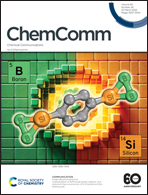Hexacoordinated tin complexes catalyse imine hydrogenation with H2†
Abstract
Frustrated Lewis pair (FLP) hydrogenation catalysts predominantly use alkyl- and aryl-substituted Lewis acids (LA) that offer a limited number of combinations of substituents, limiting our ability to tune their properties and, ultimately, their reactivity. Nevertheless, main-group complexes have numerous ligands available for such purposes, which could enable us to broaden the range of FLP catalysis. Supporting this hypothesis, we demonstrate here that hexacoordinated tin complexes with Schiff base ligands catalyse imine hydrogenation via activation of H2(g). As shown by hydrogen–deuterium scrambling, [Sn(tBu2Salen)(OTf)2] activated H2(g) at 25 °C and 10 bar of H2. After tuning the ligands, we found that [Sn(Salen)Cl2] was the most efficient imine hydrogenation catalyst despite having the lowest activity in H2(g) activation. Moreover, various imines were hydrogenated in yields up to 98% thereby opening up opportunities for developing novel FLP hydrogenation catalysts based on hexacoordinated LA of main-group elements.



 Please wait while we load your content...
Please wait while we load your content...